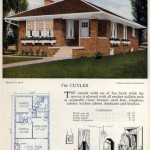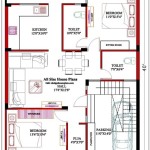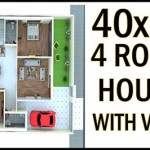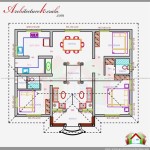Tornado Safe Home Plans: Designing for Resilience
Tornadoes are among the most destructive weather phenomena, capable of inflicting catastrophic damage on homes and infrastructure. Designing and constructing homes with specific safety features in mind can significantly increase the chances of survival and minimize property loss during a tornado event. This article explores key considerations and design principles for creating tornado-safe homes.
Understanding Tornado Forces and Vulnerabilities
Tornadoes generate intense rotational winds and pressure differentials that exert extreme forces on structures. These forces can lead to structural failure, debris impacts, and water intrusion. Common vulnerabilities in residential construction include weak connections between the roof and walls, inadequate bracing of walls, and insufficient anchoring of the foundation.
Wind forces increase exponentially with wind speed, making even modest increases in wind resistance highly beneficial. The Enhanced Fujita (EF) Scale classifies tornadoes based on damage indicators, providing a framework for understanding the wind speeds associated with various levels of destruction. Understanding the potential wind speeds in a geographic area is crucial for determining the necessary design considerations. Furthermore, understanding the pressure differential during a tornado is imperative. The rapid drop in atmospheric pressure outside the structure relative to the pressure inside can contribute significantly to structural failure. Air sealing and reinforced openings can help mitigate this pressure differential.
Debris carried by tornado winds, such as tree limbs, projectiles from damaged structures, and vehicles, poses a significant threat. Impact-resistant materials and protective measures for windows and doors are necessary to reduce the risk of injury and structural damage from debris impacts. The size, weight, and velocity of potential debris influence the severity of impacts and necessitate tailored protective measures. For instance, proximity to populated areas and dense vegetation increases the likelihood of impactful debris.
Key Design Principles for Tornado Resistance
Designing a tornado-safe home requires a holistic approach that integrates structural integrity, impact resistance, and occupant safety. Several key principles guide the design process:
Continuous Load Path: A continuous load path ensures that forces from the roof are transferred efficiently through the walls to the foundation. This requires robust connections between structural elements, utilizing materials and fasteners that can withstand high wind loads. Connections should be designed to resist both uplift and lateral forces. Metal connectors, such as hurricane clips and straps, play a crucial role in establishing this continuous load path, especially in wood-framed construction. The spacing and size of these connectors must be appropriately calculated based on anticipated wind loads.
Strengthened Walls: Wall construction must be capable of resisting both wind pressure and debris impacts. Reinforced concrete walls offer inherent resistance to wind and debris, while wood-framed walls can be strengthened with bracing, sheathing, and specialized fasteners. Shear walls, designed to resist lateral forces, are essential components of a tornado-resistant structure. The proper installation of sheathing, ensuring adequate nailing patterns and appropriate material type, is critical for the performance of shear walls. In masonry construction, reinforced grouted cells provide enhanced strength and resistance to both wind pressure and impact.
Reinforced Roof System: The roof is often the most vulnerable part of a building during a tornado. A properly designed and constructed roof system is crucial for preventing structural failure. This includes ensuring adequate connection to the walls and using durable roofing materials designed to withstand high winds and impacts. Sealed roof decks can also minimize water damage from wind-driven rain. The geometry of the roof also influences wind resistance. Hip roofs, for example, generally perform better than gable roofs in high wind conditions due to their aerodynamic shape.
Foundation Anchoring: The foundation must be adequately anchored to resist uplift forces generated by high winds. This can be achieved through the use of anchor bolts, concrete reinforcement, and a properly designed footing system. The type of soil and its load-bearing capacity must be considered when designing the foundation. Expansive soils, for instance, require special design considerations to prevent movement and potential damage to the structure. Deep foundations, such as piers or piles, can be used in areas with unstable soil conditions to provide enhanced anchoring.
Impact-Resistant Openings: Windows and doors are common points of entry for wind and debris during a tornado. Using impact-resistant glass, reinforced frames, and properly sealed openings can significantly reduce the risk of damage and injury. Storm shutters, either permanent or deployable, provide an additional layer of protection. Impact-resistant glazing is designed to withstand high-velocity impacts from debris, preventing shattering and maintaining the integrity of the building envelope. Proper sealing around windows and doors not only prevents water intrusion but also reduces the pressure differential inside the structure.
Safe Room or Storm Shelter: Incorporating a safe room or storm shelter into the home provides a dedicated refuge for occupants during a tornado. These structures are designed to withstand extreme wind loads and debris impacts, offering a high level of protection. Safe rooms can be constructed within the existing structure or as stand-alone units. Federal Emergency Management Agency (FEMA) provides guidelines for the design and construction of safe rooms, ensuring that they meet specific performance criteria. The size of the safe room should be adequate to accommodate all occupants comfortably. Ventilation is also an important consideration to prevent the buildup of carbon dioxide during extended occupancy.
Material Selection for Tornado Resistance
The choice of building materials plays a critical role in determining the overall tornado resistance of a home. Certain materials offer superior strength, durability, and impact resistance compared to others:
Reinforced Concrete: Reinforced concrete is highly resistant to wind pressure, debris impacts, and fire. Concrete homes are generally more expensive to build than wood-framed homes, but they offer a higher level of protection. Concrete can be used for walls, roofs, and foundations, providing a robust structural envelope. The addition of steel reinforcement enhances the tensile strength of concrete, making it more resistant to cracking and failure under stress.
Steel Framing: Steel framing offers high strength-to-weight ratio and resistance to rot and pests. Steel-framed homes can be designed to withstand high wind loads and are less susceptible to damage from moisture. Like concrete, steel is non-combustible, providing additional fire resistance. Proper corrosion protection is essential for steel framing to prevent rust and maintain its structural integrity over time. Welding and bolting are common methods of connecting steel framing members, ensuring a strong and durable structure.
Engineered Wood Products: Engineered wood products, such as oriented strand board (OSB) and laminated veneer lumber (LVL), offer improved strength and stability compared to traditional lumber. These materials are often used for sheathing, roof decking, and framing members in wood-framed homes. Engineered wood products are manufactured to specific performance standards, ensuring consistent quality and predictable performance. The use of adhesives in engineered wood products can make them more resistant to moisture and decay compared to solid lumber.
Impact-Resistant Glazing: Impact-resistant glazing consists of multiple layers of glass laminated together with a durable interlayer. This type of glazing is designed to withstand high-velocity impacts from debris, preventing shattering and protecting occupants from injury. Impact-resistant glazing is available in various thicknesses and configurations to meet different levels of protection. Testing standards, such as those established by the American Architectural Manufacturers Association (AAMA), ensure that impact-resistant glazing meets specific performance requirements.
High-Wind Roofing Materials: Roofing materials designed for high-wind areas include asphalt shingles, metal roofing, and concrete tiles. These materials are manufactured with specific features to resist uplift and blow-off in high winds. Proper installation is crucial for the performance of high-wind roofing materials. Adhesives, fasteners, and underlayment play a role in securing the roofing material to the roof deck and preventing wind damage. Wind ratings for roofing materials are typically expressed in miles per hour (mph) and indicate the maximum wind speed the material can withstand without failure.
Site Selection and Orientation
The location of a home and its orientation on the site can influence its vulnerability to tornado damage. Site selection should consider factors such as topography, vegetation, and proximity to other structures. Orienting the home to minimize exposure to prevailing winds and debris paths can reduce the risk of damage.
Topography: Building on higher ground can reduce the risk of flooding and debris accumulation during a tornado. Slopes and hills can also provide some protection from wind forces. However, exposed hilltops can be particularly vulnerable to high winds. The presence of natural depressions or valleys can channel wind and increase its velocity in certain areas.
Vegetation: Mature trees near a home can pose a hazard during a tornado. Falling trees and limbs can cause significant damage to the structure. Clearing trees within a certain radius of the home can reduce this risk. However, strategically placed trees can also provide some windbreak protection. The type of tree also influences its resistance to wind damage. Hardwood trees are generally more resistant to wind damage than softwood trees.
Proximity to Other Structures: Buildings in close proximity to each other can create wind tunnels and increase the velocity of wind in certain areas. Adequate spacing between buildings can reduce this effect. However, nearby structures can also provide some shielding from wind and debris. The height and shape of adjacent buildings influence the wind flow around them, potentially increasing or decreasing wind loads on the subject property.
Orientation: Orienting the long axis of the home perpendicular to the prevailing wind direction can minimize the surface area exposed to wind forces. Reducing the number of windows and doors on the windward side of the home can also reduce the risk of damage. Orienting the home to take advantage of natural windbreaks, such as hills or vegetation, can provide additional protection.
The design and construction of tornado-safe homes involve a comprehensive understanding of tornado forces, structural design principles, material selection, and site considerations. By incorporating these elements into the planning and construction process, homeowners can significantly increase the safety and resilience of their homes in the face of tornado threats.

An Ingenious Home Built To Battle Tornadoes Bloomberg

An Ingenious Home Built To Battle Tornadoes Bloomberg

First Floor Plan Of Tornado Proof House By Q4 Team Source Scientific Diagram

Q4 Architects Tornado Proof Home Is An Indestructible House Within A

Tornado Proof House By 10 Design
10 Design Architecture S Tornado Proof Home

Futuristic Tornado Proof Home Sinks Into The Ground At First Sign Of A Twister
Taking Shelter From The Storm Building A Safe Room For Your Home Or Small Business

Q4 Architects Tornado Proof Home Is An Indestructible House Within A

Tornado Proof House By 10 Design








